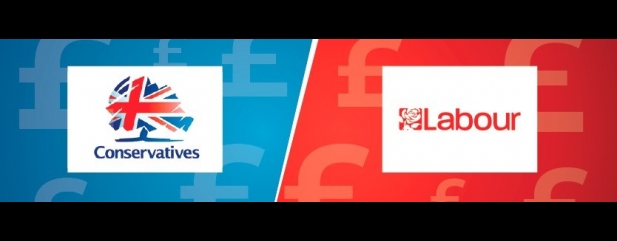Archived article
Please note that tax, investment, pension and ISA rules can change and the information and any views contained in this article may now be inaccurate.
Good and bad: how the Tories and Labour could impact your wealth

The general election date is nearing, and all the parties have pledged changes that will impact your personal finances. But how will each party’s policies affect your pocket?
TAXES
The Tory manifesto makes clear that they would raise the threshold at which you pay National Insurance from the current £8,632 to £9,500 in 2020-21. This means anyone earning more than £8,632 would benefit from the move to shift the National Insurance threshold, to the tune of around £100 a year.
By shifting National Insurance rates rather than income tax thresholds Boris Johnson extends the giveaway to the lowest earners, in particular those on less than the current £12,500 personal allowance.
In contrast, Labour would increase the number of people paying the 45% income tax rate, cutting the threshold from the current £150,000 down to £80,000, and introducing a new 50% rate for those earning more than £125,000. The move would cost taxpayers £5.4bn.
The highest earners get clobbered by this move, as more of their money will be taxed at a higher rate. For example, someone earning £100,000 would pay £1,000 a year more in tax, although someone who earned £81,000 would only pay £50 a year more. Anyone earning less than £80,000 won’t be affected by the move – meaning it only impacts around the top 5% of earners.
TAX ON INVESTMENTS
The Labour party would slash the capital gains tax allowance from the current £12,000, and will cut the dividend allowance from the current £2,000 to zero, and will tax any gains as income.
It means anyone with significant investments that aren’t in an ISA or pension would face a hike in tax rates. For the highest earners with income of £125,000 or more the shift is the biggest thanks to the introduction of Labour’s new ‘super rich’ 50% tax rate. It means that on gains their tax rate would rise from the current 20% capital gains tax rate up to 50%.
Even lower earners who take some of their income from dividends would be hit by a double whammy of the annual £2,000 tax-free dividend allowance being ditched and the raising of the tax rate from 7.5% to 20%.
Someone who is a basic-rate taxpayer with £2,000 of dividend income would pay £400 a year more in tax under Labour, while someone with £5,000 of dividend income would pay £775 more tax a year.
Most people have the bulk of their wealth in an ISA or pension, and the annual ISA allowance is now £20,000, meaning people can squirrel more of their money away from the taxman. We’d likely see more people shifting their money into their ISA or pension if Labour came to power, to help mitigate their tax hit.
INHERITANCE TAX
The Labour manifesto says that the party would reverse the recent inheritance tax cut, by scrapping the residence nil rate band, which applies when you leave your property to certain descendants. This means individuals would lose a tax break worth £175,000 each next year.
This move means a couple misses out on £350,000 a year in inheritance tax allowance, and with IHT at 40% this would cost a potential £140,000. Scrapping the allowance would lead to a 68% increase in the number of estates paying IHT by 2023-24, according to a recent report from the Office for Tax Simplification.
FAMILIES
Parents of children under two would benefit from Labour extending free childcare to two-year-olds. The manifesto doesn’t give full details but currently parents of three and four-year-olds get 30 hours of free childcare a week for 38 weeks of the year. If this was extended to two-year-olds, at average UK prices this would save parents £5,650 per child per year. Lower earners could get additional subsidised hours, but no details were given on who would benefit.
Labour plans to boost maternity pay, extending it from nine to 12 months – giving new mothers a near £2,000 boost if they take the full year off work. They would also increase paternity pay to four weeks and increase the pay for the first week by £226. In another move for families, Labour would also reverse the controversial two-child cap on child benefit.
Labour would also scrap the Marriage Allowance, which gives couples where one is a basic-rate taxpayer and the other is a non-earner or low earner the ability to transfer some of their tax-free income. Almost 1.8m people claimed the marriage allowance last year and it would cost each of those couples up to £250 each a year if the tax break is scrapped. However, the potential hit is far higher for couples who are eligible for the tax break but have failed to claim it, if they can no longer backdate their claims. At the moment couples can claim up to five years’ worth of the allowance, which is worth a maximum of £1,149 per couple.
Not to be left out the Tories pledged to increase the funding for childcare by offering up £1bn more – specifically focused on after-school and holiday childcare, but no further details were given on how this would work.
PENSIONS
Both Labour and the Conservatives have pledged to keep the triple lock on pensions. Earnings and inflation have dipped below 2.5% three times since the triple-lock was introduced at the start of the decade, ensuring the state pension has increased by at least 2.5% for millions of pensioners.
Meanwhile Labour has pledge to freeze state pension increases at 66, but there was no mention of it in the Tory manifesto. The Labour policy is good news for those retiring in the next two decades, who would receive their state pension earlier than under the current proposals.
However, Labour’s pledge was arguably the single biggest giveaway in their manifesto and yet it didn’t appear at all in the policy costings. Voters therefore need to remember that the cost of freezing the state pension age – estimated at £24bn a year by the 2050s by the IFS – will eventually land somewhere.
Both Labour and the Conservatives have promised to review pension tax incentives, with a focus on the problems facing the NHS as thousands of doctors refuse shifts due to the impact of the annual allowance taper. Neither pledged what they expect the outcome of the review would be, while scrapping the taper might be politically uncomfortable, it remains the simplest solution to the current crisis.
Also in the manifesto pledge, the Conservatives said they would review the net pay anomaly. Just like the annual allowance taper, the net pay pension scandal isn’t new but the Conservatives have failed to take any meaningful action to deal with it while in power.
The problem exists because ‘net pay’ schemes deduct pension contributions from earnings before tax, meaning those who don’t pay any tax at all – i.e. the lowest earners – don’t receive the tax relief they are entitled to.
WASPI WOMEN
Perhaps the biggest shock of this campaign so far was Labour’s promise to pay full restitution to over 3m 1950s-born women affected by increases in the state pension age. The average compensation payment is expected to be around £15,000, while reports suggest some could be in line for a payout of over £30,000. Given the size of the sum involved, this financial burden will eventually fall on taxpayers – most likely through higher taxes.
Important information:
These articles are provided by Shares magazine which is published by AJ Bell Media, a part of AJ Bell. Shares is not written by AJ Bell.
Shares is provided for your general information and use and is not a personal recommendation to invest. It is not intended to be relied upon by you in making or not making any investment decisions. The investments referred to in these articles will not be suitable for all investors. If in doubt please seek appropriate independent financial advice.
Investors acting on the information in these articles do so at their own risk and AJ Bell Media and its staff do not accept liability for losses suffered by investors as a result of their investment decisions.
Issue contents
Editor's View
Exchange-Traded Funds
Great Ideas
Great Ideas Update
News
- Japan’s public pension fund bans short-selling on ESG grounds
- Black Friday boost for retailers including Boohoo
- Good and bad: how the Tories and Labour could impact your wealth
- Investors ‘may only see small UK market bounce’ on a Tory majority win
- Activist investor accuses mainstream managers of ‘greenwash’
- What are the prospects for oil prices and big oil firms?

 magazine
magazine










